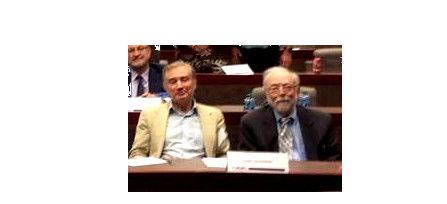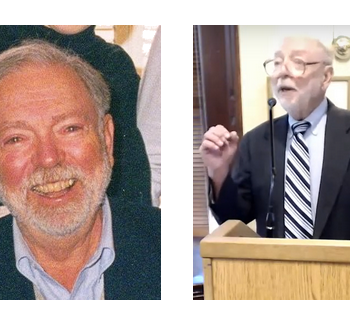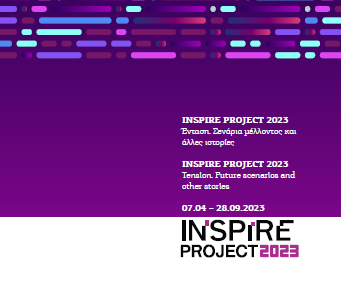
A great gentle Giant has left us
- Posted by Mara Di Berardo
- On 1 February 2024
- 0 Comments
- Jerome Glenn, Ted Gordon
By Jerome C. Glenn, Executive Director, The Millennium Project
(Spanish and Italian translations available at the bottom of the page)
Ted Gordon contributed more to futures research methodology than any other in history.
Delphi, Cross-Impact Analysis, Trend Impact Analysis, Technology Sequence Analysis, Interactive Scenario software, Decision Modelling, Substitution Analysis, State of the Future Index, What/If data base future headlines, and Real-Time Delphi.
He had completed 93 laps around the Sun and was still working on the analysis of the Artificial General Intelligence Real-Time Delphi to the end.
His futures research work went from consulting for the RAND Corporation, to helping create the Institute for the Future, and then founded the Futures Group (first for profit futurist think tank) and finally co-founding The Millennium Project.
Before working with RAND, he was the manager for the third stage of the Saturn rocket of the Apollo Mission that went to the moon. So, when someone says it doesn’t take rocket science… you can say, yes it does, and there he is! Ted was also director of Advanced Space Stations and Planetary Systems, the advanced design function of the division and was also in charge of the launch of early ballistic missiles and space vehicles from Cape Canaveral. His career at Douglas spanned a 16-year period, from 1952 to 1968, and yes, some overlap with RAND as Douglas Aircraft got the contract to create the RAND Corporation.


I first met Ted in 1971 when he came to give a talk at a graduate course on the future at the Experiment in International Living near Brattleboro, Vermont, that I helped organize when I was working on my Master’s degree for Antioch Graduate School of Education (then in Putney, Vermont, now in Keene, New Hampshire and called Antioch University New England). We would connect from time to time until 1988 when he and the Futures Group asked me to get the United Nations University to be the lead-organization for the Millennium Project – then, just an idea on paper and published in Technological Forecasting & Social Change – as a global futures research study to culminate at the Millennium – as a gift from one millennium to the next. I agreed, but didn’t want to do one more futures study, instead I thought we needed a global system for futures research. In 1988 the Cold War was still on, and the UNU did not like the idea of doing business with a for-profit organization – The Futures Group. So I was asked the bring in the Smithsonian Institution to balance off Ted, and the rest was history.
I was tele-present at Annie’s memorial service and was overwhelmed by the love of Ted’s family supporting him during his wife’s passing. He was a lucky man to have such a great wife and marriage for so many good years.
There is much more to say, and very pleased to see soooooo many saying it. Paul Saffo has suggested we create something in addition to the Family’s Memorial Service this Spring. So, ideas welcome.
Here’s to ya Ted!
With tears in my eyes,
Jerry
➡ Read the tributes from Ted Gordon’ colleagues and friends
➡ Spanish Translation of Jerome Glenn’s tribute to Ted Gordon
(courtesy of Miguel Gutierrez, Argentina Node Chair, The Millennium Project)
Queridos amigos Con gran pesar y emoción comparto esta semblanza de Ted Gordon, hecha por Jerry Glenn y en recuerdo de su paso por Buenos Aires, en el año del milenio.
Un gran Gigante gentil nos ha dejado.
Ted Gordon contribuyó más a la metodología de investigación de futuros que cualquier otro en la historia.
Delphi, análisis de impacto cruzado, análisis de impacto de tendencias, análisis de secuencia tecnológica, software de escenarios interactivos, modelado de decisiones, análisis de sustitución, índice del estado del futuro, titulares futuros de la base de datos What/If y Delphi en tiempo real.
Había completado 93 vueltas alrededor del Sol y todavía estaba trabajando en el análisis de la Inteligencia Artificial General en Tiempo Real Delphi hasta el final.
Su trabajo de investigación de futuros abarcó desde la consultoría para RAND Corporation hasta ayudar a crear el Institute for the Future, y luego fundó Futures Group (el primer grupo de expertos futuristas con fines de lucro) y finalmente cofundó The Millennium Project.
Antes de trabajar con RAND, fue el director de la tercera etapa del cohete Saturno de la Misión Apolo que fue a la luna. Entonces, cuando alguien dice que no hace falta mucha ciencia… puedes decir, sí, ¡y ahí está! Ted también fue director de Estaciones Espaciales Avanzadas y Sistemas Planetarios, la función de diseño avanzado de la división y también estuvo a cargo del lanzamiento de los primeros misiles balísticos y vehículos espaciales desde Cabo Cañaveral. Su carrera en Douglas abarcó un período de 16 años, de 1952 a 1968, y sí, algunos se superpusieron con RAND cuando Douglas Aircraft obtuvo el contrato para crear RAND Corporation.
Conocí a Ted por primera vez en 1971, cuando vino a dar una charla en un curso de posgrado sobre el futuro en el Experiment in International Living cerca de Brattleboro, Vermont, que ayudé a organizar cuando estaba trabajando en mi maestría para la Escuela de Graduados en Educación de Antioch ( luego en Putney, Vermont, ahora en Keene, New Hampshire y llamada Antioch University New England). Nos contactábamos de vez en cuando hasta 1988, cuando él y el Futures Group me pidieron que consiguiera que la Universidad de las Naciones Unidas fuera la organización líder del Proyecto del Milenio (que fue una idea escrita y publicada en Technological Forecasting & Social Change). un estudio de investigación de futuros globales que culminará en el Milenio, como un regalo de un milenio al siguiente. Estuve de acuerdo, pero no quería hacer un estudio de futuros más; en cambio, pensé que necesitábamos un sistema global para la investigación de futuros. En 1988, la Guerra Fría aún continuaba y a la UNU no le gustaba la idea de hacer negocios con una organización con fines de lucro: The Futures Group. Entonces me pidieron que trajera el Instituto Smithsonian para equilibrar a Ted, y el resto es historia.
Estuve telepresente en el funeral de Annie y me sentí abrumado por el amor de la familia de Ted que lo apoyó durante el fallecimiento de su esposa. Era un hombre afortunado de tener una esposa y un matrimonio tan maravillosos durante tantos años.
Hay mucho más que decir, y me alegra mucho ver a tantos decirlo. Paul Saffo ha sugerido crear algo además del Servicio Conmemorativo de la Familia esta primavera. Entonces, las ideas son bienvenidas.
¡Brindemos por ti, Ted!
Con lágrimas en mis ojos,
Jerry
➡ Italian Translation of Jerome Glenn’s tribute to Ted Gordon
(courtesy of Mara Di Berardo, MP Comms Director & Italy Node Co-Chair, The Millennium Project)
Un grandioso gigante buono ci ha lasciati
Ted Gordon ha contribuito alla metodologia di ricerca sui futuri più di chiunque altro nella storia.
Delphi, Analisi Cross-Impact, Analisi Trend Impact, Analisi Technology Sequence, Interactive Scenario software, Decision Modelling, Substitution Analysis, Indice dello Stato del Futuro, What/If data base future headlines, e Real-Time Delphi.
Aveva completato 93 giri attorno al Sole e stava ancora lavorando all’analisi dell’Intelligenza Artificiale Generale Real-Time Delphi, fino alla fine.
Il suo lavoro di ricerca sui futuri va dalle consulenze per la RAND Corporation e dal contributo per la creazione dell’Institute for the Future, fino a fondare poi il Futures Group (il primo think tank futurista a scopo di lucro) e infine co-fondare il Millennium Project.
Prima di lavorare con la RAND è stato il manager del terzo stadio del razzo Saturno della missione Apollo che è andato sulla luna. Quindi, quando qualcuno dice che non serve la scienza missilistica… puoi dire sì, serve, ed eccola qui! Ted è stato anche direttore delle Stazioni Spaziali Avanzate e dei Sistemi Planetari, la funzione di progettazione avanzata della divisione, ed è stato anche responsabile del lancio dei primi missili balistici e veicoli spaziali da Cape Canaveral. La sua carriera alla Douglas durò 16 anni, dal 1952 al 1968, e sì, con alcune sovrapposizioni con la RAND quando Douglas Aircraft ottenne il contratto per creare la RAND Corporation.
Ho incontrato Ted per la prima volta nel 1971 quando fece un intervento in un corso di specializzazione sul futuro presso l’Experiment in International Living vicino a Brattleboro, nel Vermont, che avevo contribuito a organizzare mentre stavo lavorando al mio master per l’Antioch Graduate School of Education (poi a Putney, Vermont, ora a Keene, New Hampshire come Antioch University New England). Ci siamo sentiti di tanto in tanto fino al 1988, quando Ted e il Futures Group mi chiesero di fare in modo che l’Università delle Nazioni Unite diventasse l’organizzazione guida del Millennium Project – allora, solo un’idea su carta e pubblicata su Technological Forecasting & Social Change – come studio di ricerca sul futuro globale da far culminare nel Millennium Project – come un dono da un millennio all’altro. Ero d’accordo, ma non volevo fare un altro studio sui futuri, pensavo invece che avessimo bisogno di un sistema globale per la ricerca sul futuri. Nel 1988 era ancora in corso la Guerra Fredda e all’ONU non piaceva l’idea di fare affari con un’organizzazione a scopo di lucro – The Futures Group. Quindi, mi chiesero di coinvolgere lo Smithsonian Institution per bilanciare Ted, e il resto è storia.
Ero virtualmente presente alla cerimonia funebre di Annie e sono rimasto sopraffatto dall’amore della famiglia di Ted che lo ha sostenuto durante la morte di sua moglie. È stato un uomo fortunato ad avere una moglie così fantastica e un matrimonio così lungo.
C’è molto altro da dire e sono molto felice di vedere così tanti che ne parlano. Paul Saffo ha suggerito di creare qualcosa in aggiunta alla cerimonia commemorativa della famiglia questa primavera. Quindi, idee sono benvenute.
Ecco a te, Ted!
Con le lacrime agli occhi,
Jerry




0 Comments